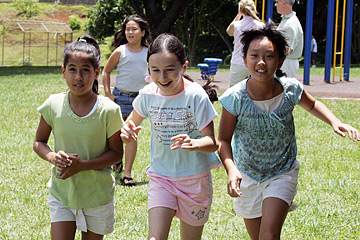
CRAIG T. KOJIMA / CKOJIMA@STARBULLETIN.COM
Kaneohe Elementary students Rachael Keane, Shannon Van Ness and Erin Kanda finish recess and head to lunch.
|
|
Play first...eat later
Kaneohe Elementary has fewer discipline problems after having kids take recess before eating lunch
HOPING to shrink the long lunch lines endured by its 600 students, Kaneohe Elementary School two years ago began sending some of its kids out to recess before eating lunch.
It seemed an unremarkable break with the traditional practice of eat, then play. But school officials quickly learned they were on to something.
The lines dwindled and the recess-first students also began to eat more of their lunch and misbehave less.
There are now fewer conflicts between bored students queuing for lunch. Ditto for the usual battles over limited playground equipment, since students are rotated outside. Disciplinary referrals have all but disappeared at the school.
Since they now have some settle-down time at the lunch table following recess, the recess-first students return to afternoon classes more calm, better fed and more ready to learn.
The change has further improved an already positive school climate, staff say, indicating that at least some seemingly thorny school problems may have simple solutions.
"We didn't expect all the other effects, but when you look at it, it makes sense. It works," said Principal Mitchell Otani.
Eating lunch first, then running it off at recess is one of the oldest of schoolyard conventions. But Otani, who runs three lunch periods to accommodate all his students, had his doubts.
"It goes against the way we were raised. You'd go out to play and then your mom yelled 'dinnertime' and you came in and ate," he said.
So when the Department of Health put out a call for a Hawaii school to pilot the new idea, Otani raised his hand.
The Health Department's Healthy Hawaii Initiative, which aims to improve student nutritional intake, hoped to replicate the success of a Montana program that cut down on wasted food.
With fifth- and sixth-graders out to recess before eating, Otani saw a sharp drop in the number of students trying to get their food at any one time, which eliminated lunch-line disciplinary problems.
"When you have students standing around together, they're going to starting playing, and that's when things happen," he said.
The wait dropped from as high as eight minutes for those at the end of the line to a typical wait these days of less than two minutes. With the exception of vegetables, the amount of wasted food decreased slightly.
One look illustrates the impact on student behavior.
On one side of the cafeteria, the school's third- and fourth-graders, still on the eat-first plan, are a pulsating mass of pent-up energy eager to bolt from half-finished plates.
Across the room, fifth-graders, their appetites stoked from a half-hour on the playground, sit calmly and devour their food.
"Many kids might skip eating lunch or rush through it so they can get to recess. Now, there's no incentive to not eat their lunch," said Cathy Tanaka, school health coordinator with the Health Department.
With different classes now rotating between the lunch table and recess, there are fewer kids on the playground at one time and thus fewer conflicts over the coveted tetherball poles or other turf, conflicts that would typically be brought into the classroom later.
"It's lessened the aggression level. The kids know they don't have to rush down anymore to be the first one to the playground," said fifth-grade teacher Julia Arrasmith.
In the afternoon, students "come back in more calm than they used to," she said, and the digestive side-effects of a rushed lunch followed by playground exertions are now less common.

CRAIG T. KOJIMA / CKOJIMA@STARBULLETIN.COM
Malia Leon, left, and Kaysie Saragosa had lunch after recess Tuesday at Kaneohe Elementary. According to school Principal Mitchell Otani, the practice of having kids take their recess before eating lunch has had some surprisingly positive effects.
|
|
"In the past it never failed -- the hand would go up: 'I've got a stomachache. Can I go to the health room?'" she said. "We don't see that as much now."
Kaneohe Elementary's pilot findings were published last year in an article in the California Journal of Health Promotion and the program was been lauded by Hawaii Board of Education members as an example of the type of outside-the-box thinking schools need.
But although Otani has received several inquiries from other local principals interested in the idea, it hasn't caught on yet, mainly because of the difficulty of arranging adequate supervision of all students at all times amid tight staffing.
Kainalu Elementary in Kailua was one of the schools that looked at the idea but backed away for this year, said Principal Sheri Sunabe.
"We do have long lunch lines, but we couldn't figure out how we'd manage (recess before lunch) this year," she said. "But we're going to relook at it again."
Otani said arranging supervision remains a struggle, but he's still drawing up plans to include other grades.
"We've managed to do it OK, but it would be very hard for a school with even less resources and there's no way you can do the whole school," he said. "But we feel the positives have outweighed the logistical problems."
PROOF POSITIVE
By changing the lunch schedule so that some grades take recess before eating, Kaneohe Elementary has discovered a host of positive effects that have contributed to an improved school climate. They include:
» Disciplinary referrals dropped to zero from about 14 a month.
» Students ate more of their nutritionally balanced school lunches.
» Students' average wait time for lunch was cut by more than half.
» Conflicts between students are less common.
» Teachers say students return better fed, calmer and ready to learn.
|

